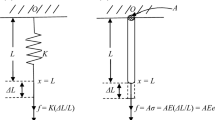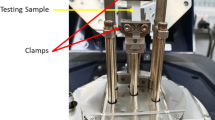Abstract
Use of “force” and “geometric” “deformation” variants of the nonlinear-hereditary viscoelasticity equation for prediction of complex processes by calculation is examined on the example of deformation-recovery and reverse relaxation processes in Lavsan synthetic fibres. A comparison of the calculated and measured values allows recommending the method of calculated prediction in which an elementary function — the normalized arctangent of the logarithm of the reduced time serves as the normalized relaxation or creep function.
Similar content being viewed by others
REFERENCES
T. Alfrey, Mechanical Properties of High Polymers, Wiley, New York (1948).
A. G. Makarov and A. M. Stalevich, Vest. SPGUTD, No. 3, 34–40 (1999).
A. M. Stalevich and A. G. Makarov, Khim. Volokna, No. 6, 68–70 (2001).
A. G. Makarov, Izv. Vyssh. Uchebn. Zaved., Tekhnol. Tekst. Prom., No. 2, 12–16 (2000).
A. G. Makarov and A. M. Stalevich, Khim. Volokna, No. 5, 58–61 (2001).
A. M. Stalevich and A. V. Demidov, Physical Chemistry of Polymers. Synthesis, Properties, and Use [in Russian], No. 6, Tver' (2000), pp. 82–91.
Author information
Authors and Affiliations
Rights and permissions
About this article
Cite this article
Makarov, A.G., Stalevich, A.M. Prediction of Reverse Relaxation and Deformation—Recovery Processes in Synthetic Fibres. Fibre Chemistry 34, 448–451 (2002). https://doi.org/10.1023/A:1022968410322
Issue Date:
DOI: https://doi.org/10.1023/A:1022968410322




